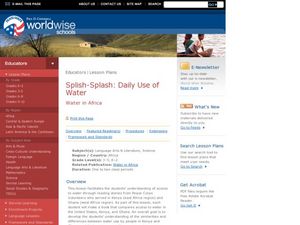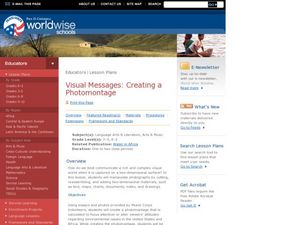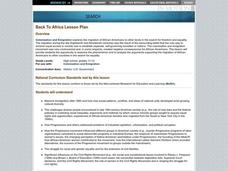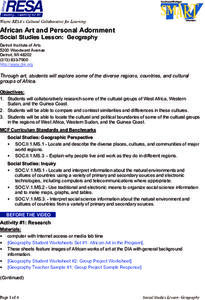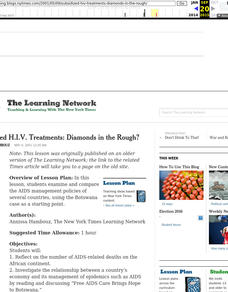Curated OER
Splish-Splash: Daily Use of Water
Learners explore the daily use of water in Kenya and Ghana. In this Peace Corps lesson, students compare similarities and differences between water use by people in Kenya and Ghana and their own communities as they create books that...
Curated OER
African American Voices
Students investigate the many forms of Haitian art. They compare the art of some different cultures, religions, countries, and philosophies. Students also read the biography of an artist to build context for a particular piece of...
Curated OER
The Countries of Slave Trade
Pupils create graphs, routes, and write an essay based on their research of the slave trade. In this slave trade lesson plan, students research the Middle Passage and how slave trade happened in the United States.
Global Oneness Project
Far From Home
A timely and provocative lesson inspires high schoolers to tackle the Syrian refugee crisis. They analyze a compelling photo essay before discussing and writing about it.
Curated OER
My World - Africa Scavenger Hunt
Students explore the lives of students living in Africa, learn African traditions, and compare and contrast their lives with the lives of African Students.
Curated OER
Studying Mind Maps Created at Other Schools
Students explore Africa and mind maps created by students from other schools. They discuss Africa and the number of countries, diversity of language, cultures, races, religions, and lifestyles and in groups study a mind map from another...
Curated OER
Examining What Sharing Really Means
After reading "The Senegalese Miracle" about the degree of sharing the author encounters upon arrival in Africa, class members read Mike Tidwell’s “Sharing in Africa” and compare the two stories. This cultural diversity lesson concludes...
Curated OER
Visual Messages: Creating a Photomontage
Students create a photomontage. In this instructional activity on photography as a means of conveying emotion, students use images gathered from the Internet to create a photomontage comparing how water is used in Africa and the U.S.
Curated OER
Songs of Mass and Individual Protest: USA, Jamaica, and South Africa
Learners study songs of mass and individual protest. They view a video clip and discuss the song and words the protesters sing. They study the song, "We Shall Overcome" and discuss the characteristics of the song and chant and sing it....
Curated OER
Back To Africa
Learners analyze the massive immigration after 1850 and how new social patterns, conflicts, and ideas of national unity developed amid growing cultural diversity, and how the Progressive movement influenced different groups in American...
Curated OER
Recipes from Africa and Asia
Seventh graders research Internet sites that provide recipes from Asian and African countries. They compile the recipes in a database. After compilation, they can sort the database for similarities and differences in ingredients.
Curated OER
The East Africa Times
Students work in teams as editors to design the front page of a newspaper covering a country in east Africa. They individually research and write articles that define modern life for the country's citizens.
Curated OER
Building Bridges for Young Learners--Culture
Young scholars explore the concept of "culture." In this cross curriculum literacy and world history lesson, students listen to a letter written by a child from Namibia, then compare and contrast life in Africa with their own life. Young...
Peace Corps
Cuisine and Etiquette
Students identify the main food in the different cultures they have examined. In groups, they compare and contrast their expected table manners to the ones in Sierra Leone, Uganda and Zambia. Using this list of behaviors, they identify...
Curated OER
Family Sells House to Help the Hungry
Students compare their wants and needs, then read a news article about a family that downsized their home to help African villagers. In this current events and poverty in Africa lesson, the teacher introduces the article with a...
Curated OER
Hershey and the World: The 5 Themes of Geography and Google Earth
Learners invsestigate cocoa producing regions in the world. In this geography skills lesson, students examine how the 5 themes of geography affect the Hershey Chocolate Company as they compare and contrast cocoa production in America,...
Curated OER
Geography
Students work together in groups to research the cultural groups of West Africa, Sudan and the Guinea Coast. They compare and contrast each culture and locate the political and cultural boundaries on a map.
Curated OER
Apartheid and Segregation
Students view a television program that depicts the history South African Apartheid and the United States' system of segregation. They discuss how laws were used to uphold these institutions and compare and contrast racism and...
Curated OER
First Black US Congresswoman Dies
In this English activity, students discuss Shirley Chisholm. Students debate and discuss American politics, focusing on Shirley Chisholm. Students discuss the differences compared to their own country of origin.
Curated OER
The Killing Fields
Eleventh graders explore ethnic divisions in the West African nation of Ivory Coast and research instances of ethnic cleansing in nations throughout history. They create global history textbook entries that explore, compare and contrast...
Curated OER
Sharia
Students examine the story of a woman convicted of adultery and sentenced to death. They identify terms associated with Islamic law and beliefs. They compare and contrast this case with the American legal system.
Curated OER
Water, Water Everywhere?
Students discover the relationship between water availability and population growth. They change variables in a computer model using a worksheet to guide their hypotheses and conclusions. In small groups they choose a country undergoing...
Curated OER
Subsidized H.I.V. Treatments: Diamonds in the Rough?
Students examine and compare the AIDS management policies of several countries, using the Botswana case as a starting point
Curated OER
Why Can't I Vote?
Fourth graders take an unannounced test (failure is expected) and the top scores are rewarded with candy bars. They compare this test to the literacy tests given before 1960 and votes to candybars. They journal their responses.


